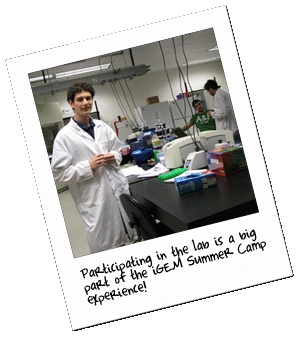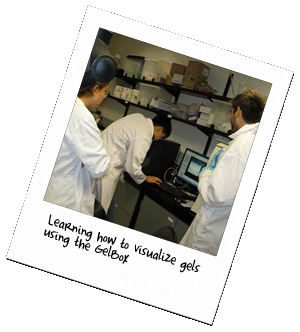Team:Calgary/Human Practices/Outreach/Workshops
From 2009.igem.org
(Difference between revisions)
| (8 intermediate revisions not shown) | |||
| Line 73: | Line 73: | ||
<br> | <br> | ||
<div class="heading"> | <div class="heading"> | ||
| - | iGEM | + | iGEM SUMMER CAMP |
</div> | </div> | ||
<div class="desc"> | <div class="desc"> | ||
<img src="http://i1001.photobucket.com/albums/af132/igemcalgary/hp.gif"> | <img src="http://i1001.photobucket.com/albums/af132/igemcalgary/hp.gif"> | ||
| + | <br> | ||
| + | <table> | ||
| + | <tr> | ||
| + | <td> | ||
| + | <br> | ||
| + | Over the summer, we were privileged to have been able to bring in high school students not only into our labs, but our entire working space. These students were either entering Grade 12 or 1st year university and were welcomed into our labs because of their knowledge about the presence of the UofC iGEM team and their interest in our work. The students were here from anywhere from one day to an entire week. The students looked into what iGEM and Synthetic Biology are before coming into the labs, but when they came in, they thought that our team was purely devoted to the wetlab. The students were first able to shadow the lab members while performing experiments and then after some time in the lab, actually got to help out with the project themselves. | ||
<br> | <br> | ||
</html> | </html> | ||
[[Image:Calgary_Summercamp2.gif]] | [[Image:Calgary_Summercamp2.gif]] | ||
| + | <html> | ||
| + | </td> | ||
| + | <td valign="top"> | ||
| + | </html> | ||
[[Image:Calgary_Summercamp1.gif]] | [[Image:Calgary_Summercamp1.gif]] | ||
<html> | <html> | ||
| + | <br> | ||
| + | Although we explained the wetlab aspect to our project, we also went over the Second Life, Modelling and Outreach initiatives. Our Second Life team helped our visiting students create avatars and explore our island. They provided useful feedback and thought this tool would be incredibly helpful for being introduced to synthetic biology. Overall, iGEM Summer Camps helped to get the word out about iGEM and to get the students interested in participating. The students are not only interested to see how the UofC iGEM team does at MIT alongside their respective universities. | ||
| + | </td> | ||
| + | </tr> | ||
| + | </table> | ||
| + | <br> | ||
</div> | </div> | ||
</td> | </td> | ||
| Line 127: | Line 143: | ||
<div class="heading">Julia Martin</div> | <div class="heading">Julia Martin</div> | ||
<div class="desc"> | <div class="desc"> | ||
| - | <i>Julia is a second year science student at Dalhousie University</i> | + | <i>Julia is a second year science student at Dalhousie University.</i> |
| + | <br> | ||
<br> | <br> | ||
Previous to my tour of the iGEM lab at the University of Calgary I was unfamiliar with the project, really only having heard snippets here and there about it from my friend, and UofC iGEMer, Jeremy. I had no idea that there was such a fantastic undergraduate initiative out there for students to engage in! One of a kind, I discovered that iGEM was an international competition utilizing techniques in the up-and-coming field of synthetic biology to engineer and modify basic processes of life. I was intrigued that iGEMers literally got to play around with bacteria and make them do such things as glow green or smell like bananas as if they were LEGO. I find it remarkable that although the actual work involved in producing these results is a great deal more tedious and complex then simple LEGO pieces, the fact that these results can be produced is revolutionary. | Previous to my tour of the iGEM lab at the University of Calgary I was unfamiliar with the project, really only having heard snippets here and there about it from my friend, and UofC iGEMer, Jeremy. I had no idea that there was such a fantastic undergraduate initiative out there for students to engage in! One of a kind, I discovered that iGEM was an international competition utilizing techniques in the up-and-coming field of synthetic biology to engineer and modify basic processes of life. I was intrigued that iGEMers literally got to play around with bacteria and make them do such things as glow green or smell like bananas as if they were LEGO. I find it remarkable that although the actual work involved in producing these results is a great deal more tedious and complex then simple LEGO pieces, the fact that these results can be produced is revolutionary. | ||
| Line 156: | Line 173: | ||
</table> | </table> | ||
</center> | </center> | ||
| + | <div class="heading">Nicole Delaloye</div> | ||
| + | <div class="desc"> | ||
| + | <i>Nicole is a sophomore at Rice University down in Houston, TX. She is a member of their varsity swim team and is currently studying biology.</i> | ||
| + | <br> | ||
| + | <br> | ||
| + | This past summer, I had the opportunity to take a tour of University of Calgary’s iGEM lab. And to be honest, before I entered that lab I had no clue whatsoever of what iGEM actually was. However, during my tour I learned all about the iGEM competition and what it entitled; how each team was given identical kits and then set free to go explore the new realm of synthetic biology. I loved the idea of how much independence students received on this research opportunity, never before had I ever heard of such a thing. During my tour I was even given the opportunity to go work in the lab, donning lab coat and latex gloves, I grew my first bacteria culture ever. After spending the afternoon with the University of Calgary’s iGEM team, I have never found myself so excited about biology. This stuff even topped my first dissection. iGEM seems like the best research opportunity a student could ever have. Not only does iGEM offer students a chance to work in the newly emerging field of synthetic biology, but it also gives them an opportunity to work with a team of students who are wholly committed to the competition. After learning that iGEM is an international competition, I found out that Rice University has a team competing as well. I’m not only excited to see how both the UofC and Rice teams do at the iGEM Jamboree, but also to hopefully be a part of either team in 2010. | ||
| + | <br><br> | ||
| + | |||
| + | </div> | ||
</td> | </td> | ||
</tr> | </tr> | ||
</table> | </table> | ||
| + | |||
</body> | </body> | ||
</html> | </html> | ||
Latest revision as of 00:37, 21 October 2009
UNIVERSITY OF CALGARY

|
STUDENT EXPERIENCES
Here are some thoughts from a few of the high school and undergraduate students who took part in our iGEM Summer Camp:
Julia Martin
Julia is a second year science student at Dalhousie University.
Previous to my tour of the iGEM lab at the University of Calgary I was unfamiliar with the project, really only having heard snippets here and there about it from my friend, and UofC iGEMer, Jeremy. I had no idea that there was such a fantastic undergraduate initiative out there for students to engage in! One of a kind, I discovered that iGEM was an international competition utilizing techniques in the up-and-coming field of synthetic biology to engineer and modify basic processes of life. I was intrigued that iGEMers literally got to play around with bacteria and make them do such things as glow green or smell like bananas as if they were LEGO. I find it remarkable that although the actual work involved in producing these results is a great deal more tedious and complex then simple LEGO pieces, the fact that these results can be produced is revolutionary. Moreover, I found out that the U of C iGEM team is not merely concerned with lab work. It was interesting to see how they had members working fulltime in other initiatives such as SecondLife, Marketing and Ethics. I liked the fact that were so many aspects to the project and that there were different things within iGEM to be involved in, whatever your interests. In addition, I really admired the U of C team because it seemed that they had built a strong working relationship and were on track to start building a community. The facilitator of the project, Sonja, allowed freedom within the project that allowed for all kinds of hands-on learning, and it sounds like the team members were able to learn more than they did in any type of biology class. I admired the sense of trust and support that the lab seemed to have, and I am excited to hopefully be a part of iGEM myself in the future!
Nicole Delaloye
Nicole is a sophomore at Rice University down in Houston, TX. She is a member of their varsity swim team and is currently studying biology.
This past summer, I had the opportunity to take a tour of University of Calgary’s iGEM lab. And to be honest, before I entered that lab I had no clue whatsoever of what iGEM actually was. However, during my tour I learned all about the iGEM competition and what it entitled; how each team was given identical kits and then set free to go explore the new realm of synthetic biology. I loved the idea of how much independence students received on this research opportunity, never before had I ever heard of such a thing. During my tour I was even given the opportunity to go work in the lab, donning lab coat and latex gloves, I grew my first bacteria culture ever. After spending the afternoon with the University of Calgary’s iGEM team, I have never found myself so excited about biology. This stuff even topped my first dissection. iGEM seems like the best research opportunity a student could ever have. Not only does iGEM offer students a chance to work in the newly emerging field of synthetic biology, but it also gives them an opportunity to work with a team of students who are wholly committed to the competition. After learning that iGEM is an international competition, I found out that Rice University has a team competing as well. I’m not only excited to see how both the UofC and Rice teams do at the iGEM Jamboree, but also to hopefully be a part of either team in 2010. |
 "
"













